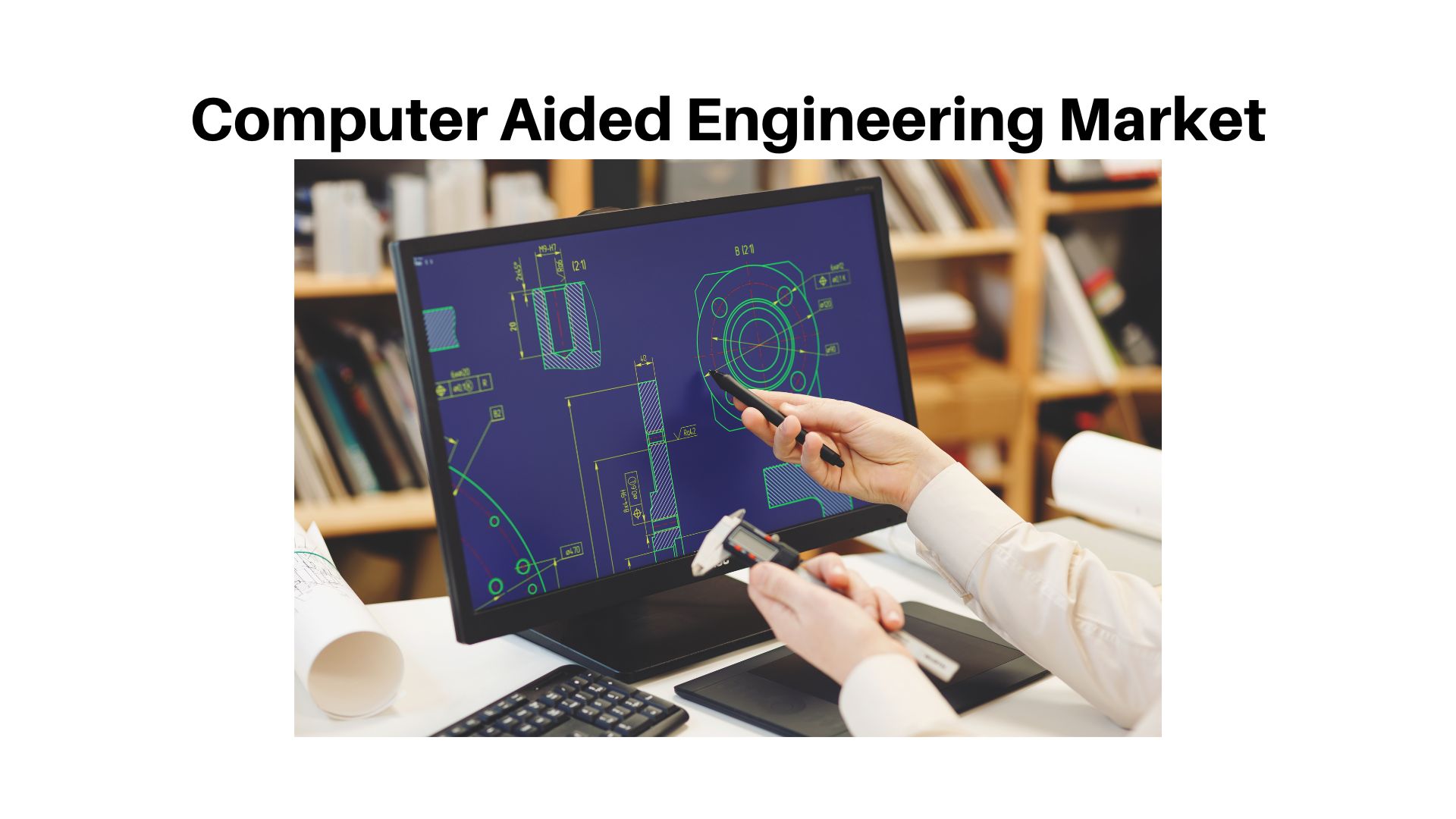Global Computer Aided Engineering Market Set for Rapid Growth to Reach Around USD 11.42 Bn by 2033

Page Contents
Market Overview
Published Via 11Press: Computer-Aided Engineering Market refers to the practice of using computer software to simulate and assess the performance and behavior of engineering designs, offering powerful tool for product development, optimization, and analysis. CAE spans multiple engineering disciplines, such as structural analysis, thermal analysis, fluid dynamics simulations, electromagnetics modeling and optimization. CAE allows engineers to test and evaluate designs before being physically constructed for increased time savings during product development cycle.
The Computer Aided Engineering Market size is expected to reach USD 11.42 Bn by 2033, up from its current value of USD 4.75 Bn in 2022, growing at an annual compound growth rate (CAGR) of 8.3% from 2023-2033.
CAE software provides engineers with detailed insights into how a product will perform under various conditions, enabling them to optimize design parameters and make informed decisions. Furthermore, this tool enables engineers to explore alternative designs while early detecting any design flaws during development. CAE analysis has become more prevalent across industries like automotive, aerospace, and consumer goods manufacturing. Engineers employing CAE as part of product design can use it to produce more efficient, reliable, and safe products.
Key Takeaways
- CAE employs computer simulation software to simulate and assess the performance and behavior of engineering designs.
- CAE encompasses an expansive spectrum of engineering disciplines, such as structural analysis, thermal analysis, fluid dynamics simulation, electromagnetics optimization, and more.
- CAE software enables engineers to test and evaluate designs before physically building them, saving both time and money during product development cycles.
- CAE software can give engineers accurate predictions of a product's performance under various environmental conditions, helping them optimize design parameters and make informed decisions.
- CAE technology has become more prevalent across industries such as automotive, aerospace and consumer products.
- CAE can be an indispensable asset to engineers looking to design products with improved efficiency, reliability and safety in mind.

Request Sample Copy of Computer Aided Engineering Market Report at: https://marketresearch.biz/report/computer-aided-engineering-market/request-sample/
Regional Snapshot
- North America: The United States and Canada are pioneers in using CAE for aerospace, automotive and defense applications. Many major CAE software providers can be found here as well.
- Europe: Germany, France and the UK are major users of CAE in Europe with particular expertise in using it in automotive and aerospace manufacturing industries. Other European nations, such as Italy and Spain are increasingly adopting CAE within their manufacturing sectors.
- Asia-Pacific: Japan, China and South Korea are major consumers of CAE in this region, especially within automotive and electronics industries. India and Southeast Asia also present opportunities for CAE use.
- Middle East & Africa: CAE use is increasing across Middle Eastern and African industries such as aerospace, defense and oil & gas.
- Latin America: Brazil and Mexico are leading users of CAE software in Latin America, specifically with regards to automotive and aerospace industries.
Drivers
- Cost Savings: One of the primary motivations behind CAE use is cost savings. By simulating and analyzing designs before physical prototypes are produced, engineers can identify potential issues early in development and address them before costly design alterations and redesign become necessary.
- Time-to-market: CAE can significantly shorten time-to-market by streamlining product development cycles. By identifying potential design issues early, engineers can make informed decisions more quickly and develop products more efficiently.
- Innovation: CAE allows engineers to explore novel design concepts and optimize existing ones, leading to more innovative products that better meet customer needs in an increasingly crowded market.
- Competitive Advantage: CAE can give companies an edge by helping them develop products with improved efficiency, reliability, and safety that ultimately increase market share and profits.
- Compliance: In many industries, regulatory compliance is of utmost importance. CAE can assist companies in meeting all applicable standards and requirements to reduce recalls or legal issues that could cost time and money to deal with.
Restraints
- Costly Initial Investment: The initial costs associated with CAE software implementation and training can be significant. This may present a barrier for small and midsized enterprises (SMEs) lacking resources to invest in this technology.
- Complexity: CAE software can be difficult to navigate, requiring specialized knowledge and training for effective use. This can present engineers and SMEs without access to this expertise with challenges in using it effectively.
- Data Quality: The accuracy of CAE simulations depends heavily on the quality and completeness of its input data. If that input data is inaccurate or incomplete, results of simulation may not be reliable and lead to incorrect design decisions.
- Legal Implications: Using CAE can raise legal concerns if its results are inaccurate, or if a product fails to meet regulatory standards. This may result in costly recalls and irreparable damage to a company's reputation.
- Integration with Other Systems: When using CAE software in conjunction with other systems like product lifecycle management (PLM) software, integration may present challenges.
Opportunities
- Increased Efficiency: CAE can greatly boost product development efficiency by enabling engineers to easily simulate and analyze designs more rapidly. This can significantly cut time and costs associated with product creation while speeding time-to-market.
- Expanded Capabilities: As CAE software becomes more sophisticated, additional capabilities are being added that enable engineers to simulate and analyze more complex designs. These include simulating multi-physics interactions between fluid and structures as well as performing optimization studies to increase product performance.
- Customization: Most CAE software packages allow organizations to tailor the software specifically to meet their organization's individual requirements, which can help improve workflow and streamline design processes. This may allow an organization to improve workflow while optimizing design processes.
- Collaboration Improvement: CAE software can enable engineers to collaborate more effectively on designs across different locations, leading to enhanced communication, increased design quality and more efficient decision-making processes.
- Emerging Markets: With emerging markets experiencing exponential growth and development, demand for CAE software to support product development in industries like automotive, aerospace and electronics continues to surge.
Challenges
- Complexity: CAE software can be complex, with a steep learning curve for engineers to master it efficiently – this can take considerable time and expense for training purposes.
- Data Quality: Accuracy in CAE simulations hinges upon the quality of input data, and this may prove challenging when the information needed may be incomplete, inaccurate, or hard to come by.
- Computing Power: CAE simulations require considerable computing power, which may pose a difficulty for organizations without access to high-performance computing resources.
- Integration With Other Systems: CAE software must be seamlessly integrated with other systems, including product lifecycle management (PLM) software. However, this can prove a daunting challenge as different software packages may not be compatible.
- Validation: CAE simulations must be validated to ensure they accurately reflect real-world conditions, but this can be challenging as it requires access to real-world data which may not always be readily available.
- Cost: Implementing CAE can be costly for small and midsized enterprises (SMEs) without sufficient financial resources to invest in this technology.
Market Segmentation
End User
- Aerospace
- Automobile
- Electrical and electronics
- Defense
- Industrial machinery
- Others
product
- Finite Element Analysis (FEA)
- Computational Fluid Dynamics (CFD).?
Key Players
- PLM Software Inc.
- MSC Software Corporation
- Bentley Systems Inc.
- Dassault Systemes S.A.
- Synopsys Inc.
- ANSYS Inc.
- Middle EastMentor Graphics Corporation
- AspenTech
- ESI Group
- Exa Corporation
- Numeca International
Report Scope
| Report Attribute | Details |
| Market size value in 2022 | USD 4.75 Bn |
| Revenue forecast by 2033 | USD 11.42 Bn |
| Growth Rate | CAGR Of 8.3% |
| Regions Covered | North America, Europe, Asia Pacific, Latin America, and Middle East & Africa, and Rest of the World |
| Historical Years | 2017-2022 |
| Base Year | 2022 |
| Estimated Year | 2023 |
| Short-Term Projection Year | 2028 |
| Long-Term Projected Year | 2033 |
Recent Developments
- Cloud-Based CAE: Many CAE software providers now provide cloud-based solutions, allowing users to access the software from any internet-enabled location – providing greater flexibility and scalability, as well as eliminating costly hardware investments.
- Simulation-Driven Design (SDD): Simulation-driven design is an approach that employs CAE simulations to drive product design processes. By optimizing designs using CAE simulations, engineers can produce better products faster while spending fewer resources.
- Artificial Intelligence (AI) and Machine Learning (ML): Artificial intelligence and machine learning technologies have become a growing presence in CAE, being increasingly employed to automate tasks such as meshing and model setup, saving engineers both time and improving accuracy in simulations.
- Multi-physics Simulation: Multi-physics simulation entails the incorporation of different physical phenomena, such as fluid dynamics and structural analysis, into one simulation environment to better model complex systems and optimize designs. Engineers use this technology to more accurately model these systems while creating optimized designs.
- Virtual reality (VR) and augmented reality (AR): VR and AR have become popular CAE tools due to their immersive visualizations that help engineers better comprehend and communicate complex designs.
- Open-source CAE software such as OpenFOAM and CalculiX have become popular alternatives to proprietary CAE packages due to their free availability and large user communities that can provide invaluable support and resources.
Key Questions
Q: What Is Computer-Aided Engineering (CAE)?
A: Computer-Aided Engineering (CAE) refers to using computer software to simulate, analyze, and optimize designs. CAE software can simulate various physical phenomena including structural mechanics, fluid dynamics, and electromagnetics.
Q: What are the benefits of CAE?
A: CAE can offer several advantages, including increased design accuracy, shorter product development cycles, lower costs, and increased innovation. CAE simulations enable engineers to identify design flaws early in product development processes – potentially saving both time and money.
Q: What are the challenges associated with CAE?
A: Common challenges when using CAE include software complexity, data quality and computing power issues as well as integration with other systems and validation issues as well as cost considerations.
Q: What have been recent developments in CAE?
A: Recent advances include cloud-based solutions, simulation-driven design techniques, AI/ML utilization for multiphysics simulation, VR/AR support and open CAE software platforms.
Q: What is the Future of CAE?
A: CAE's future appears promising with continued advances in AI and ML technologies, greater use of cloud-based solutions, tighter integration between systems, as well as wider adoption of open source CAE software. Furthermore, there will likely be an emphasis placed on sustainability and environmental impact when simulating CAE simulations.
Contact us
Contact Person: Mr. Lawrence John
Marketresearch.Biz (Powered By Prudour Pvt. Ltd.)
Tel: +1 (347) 796-4335
Send Email: [email protected]
The team behind market.us, marketresearch.biz, market.biz and more. Our purpose is to keep our customers ahead of the game with regard to the markets. They may fluctuate up or down, but we will help you to stay ahead of the curve in these market fluctuations. Our consistent growth and ability to deliver in-depth analyses and market insight has engaged genuine market players. They have faith in us to offer the data and information they require to make balanced and decisive marketing decisions.



